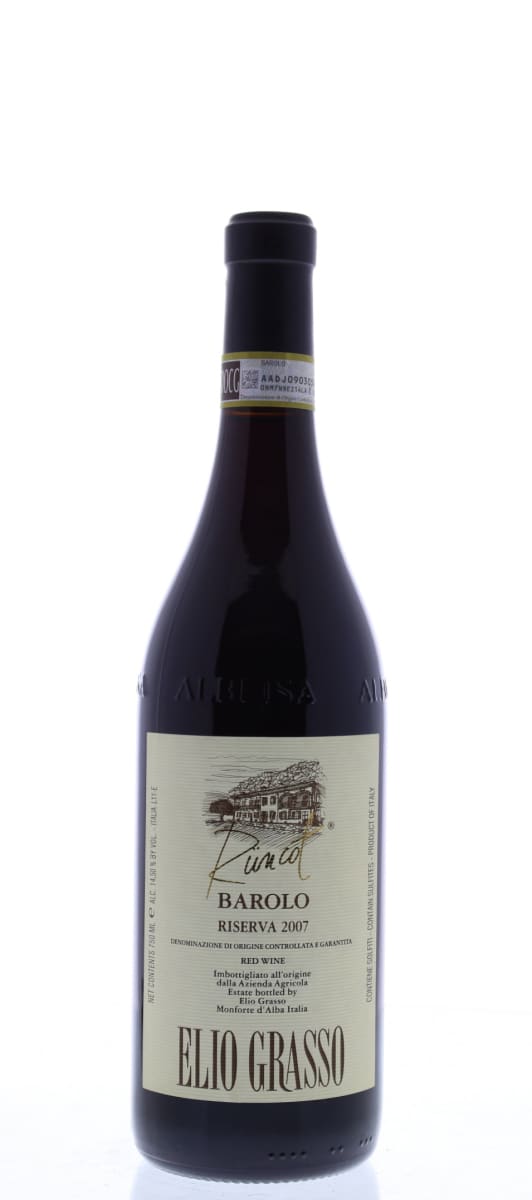Elio Grasso Barolo Runcot Riserva 2007
-
Wine
Spectator




Product Details
Your Rating
Somm Note
Winemaker Notes
Professional Ratings
-
Wine Spectator
Rich and open, offering a lush, velvety texture and ripe cherry notes that conceal a core of iron, licorice and eucalyptus. This is firm, focused and vibrant, with lively acidity driving the fresh, resonant finish. Approachable now, but should be better in a few years. Best from 2015 through 2030.
Other Vintages
2015-
Robert
Parker -
James
Suckling -
Wine
Spectator
-
Robert
Parker -
James
Suckling -
Wine
Spectator
-
James
Suckling -
Wine
Spectator




Currently, the Elio Grasso estate has a productive vineyard holding of 14 hectares. The cellar uses only estate-grown grapes from varieties traditionally grown, with excellent results, in the Langhe hill country near Alba.
Reflecting the imprint of the vineyard where the fruit was grown in order to give our wines their unique personality is the goal that we - myself, my wife Marina and our son, Gianluca - strive to achieve, with the invaluable assistance of our consultant wine technician, Piero Ballario.
We believe that to be acknowledged first as grape farmers, and then as wine producers, is the best way to honour, and continue the labours of, those who have faced before us the challenges that working with nature and her products, like wine, entails. This, and a desire to be true to ourselves, prompts us propose, without presumption, the convictions and conduct shared by all Langhe farming families, characteristics worth preserving and which we believe make the difference.

Responsible for some of the most elegant and age-worthy wines in the world, Nebbiolo, named for the ubiquitous autumnal fog (called nebbia in Italian), is the star variety of northern Italy’s Piedmont region. Grown throughout the area, as well as in the neighboring Valle d’Aosta and Valtellina, it reaches its highest potential in the Piedmontese villages of Barolo, Barbaresco and Roero. Outside of Italy, growers are still very much in the experimentation stage but some success has been achieved in parts of California. Somm Secret—If you’re new to Nebbiolo, start with a charming, wallet-friendly, early-drinking Langhe Nebbiolo or Nebbiolo d'Alba.

The center of the production of the world’s most exclusive and age-worthy red wines made from Nebbiolo, the Barolo wine region includes five core townships: La Morra, Monforte d’Alba, Serralunga d’Alba, Castiglione Falletto and the Barolo village itself, as well as a few outlying villages. The landscape of Barolo, characterized by prominent and castle-topped hills, is full of history and romance centered on the Nebbiolo grape. Its wines, with the signature “tar and roses” aromas, have a deceptively light garnet color but full presence on the palate and plenty of tannins and acidity. In a well-made Barolo wine, one can expect to find complexity and good evolution with notes of, for example, strawberry, cherry, plum, leather, truffle, anise, fresh and dried herbs, tobacco and violets.
There are two predominant soil types here, which distinguish Barolo from the lesser surrounding areas. Compact and fertile Tortonian sandy marls define the vineyards farthest west and at higher elevations. Typically the Barolo wines coming from this side, from La Morra and Barolo, can be approachable relatively early on in their evolution and represent the “feminine” side of Barolo, often closer in style to Barbaresco with elegant perfume and fresh fruit.
On the eastern side of the Barolo wine region, Helvetian soils of compressed sandstone and chalks are less fertile, producing wines with intense body, power and structured tannins. This more “masculine” style comes from Monforte d’Alba and Serralunga d’Alba. The township of Castiglione Falletto covers a spine with both soil types.
The best Barolo wines need 10-15 years before they are ready to drink, and can further age for several decades.
